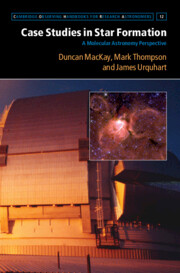Book contents
- Frontmatter
- Dedication
- Contents
- Preface
- List of Acronyms
- Part I Introduction
- 1 An Overview of Star Formation
- Part II Low-Mass Star Formation (LMSF)
- Part III High-Mass Star Formation (HMSF)
- Part IV Ionisation
- Part V Photodissociation
- Part VI External Galaxies
- Appendices
- List of Research Journal Abbreviations
- References
- Chemical Index
- Subject Index
1 - An Overview of Star Formation
from Part I - Introduction
Published online by Cambridge University Press: 11 April 2023
- Frontmatter
- Dedication
- Contents
- Preface
- List of Acronyms
- Part I Introduction
- 1 An Overview of Star Formation
- Part II Low-Mass Star Formation (LMSF)
- Part III High-Mass Star Formation (HMSF)
- Part IV Ionisation
- Part V Photodissociation
- Part VI External Galaxies
- Appendices
- List of Research Journal Abbreviations
- References
- Chemical Index
- Subject Index
Summary
The opening chapter introduces the most significant areas of contemporary research in the molecular astronomy of star formation: prestellar cores, hot cores, hot corinos, accretion, protoplanetary disks, photodissociation regions (PDRs), HII regions, stellar jets, disk winds, outflows, and masers. These sit within the wider considerations of dense molecular clouds on many scales, from the giant molecular clouds (GMCs) to fragments, filaments, and clumps. Our understanding of these molecular cloud environments depends on our understanding of molecular excitation, energy balance, gas and grain surface reaction kinetics, cosmic ray ionization, and photochemistries. Chemical modelling involving both gas-phase and grain-surface reactions is described, as are the observational and analytical essentials of antenna temperature, optical depth, velocity distribution, column density, beam dilution, relative abundance, rotation diagrams, and radiative transfer modelling.
Keywords
- Type
- Chapter
- Information
- Case Studies in Star FormationA Molecular Astronomy Perspective, pp. 3 - 24Publisher: Cambridge University PressPrint publication year: 2023



